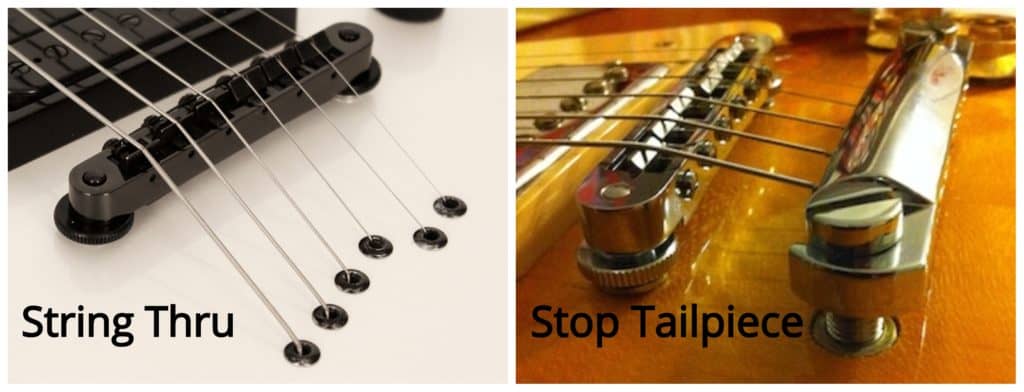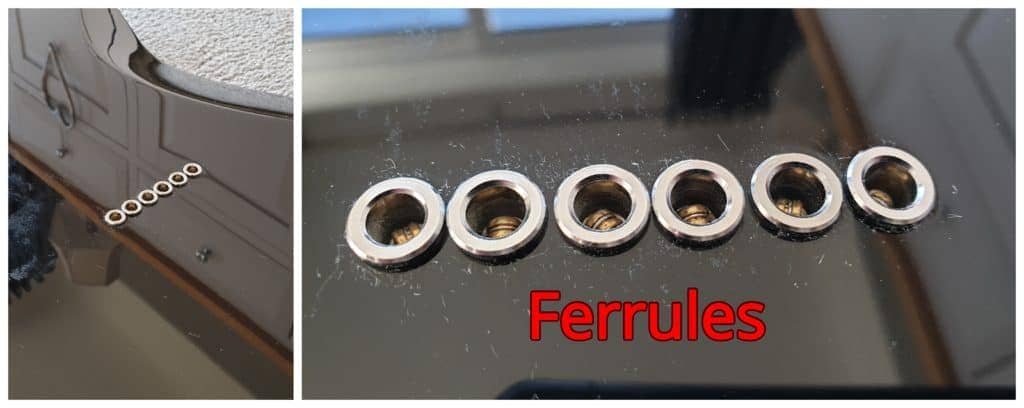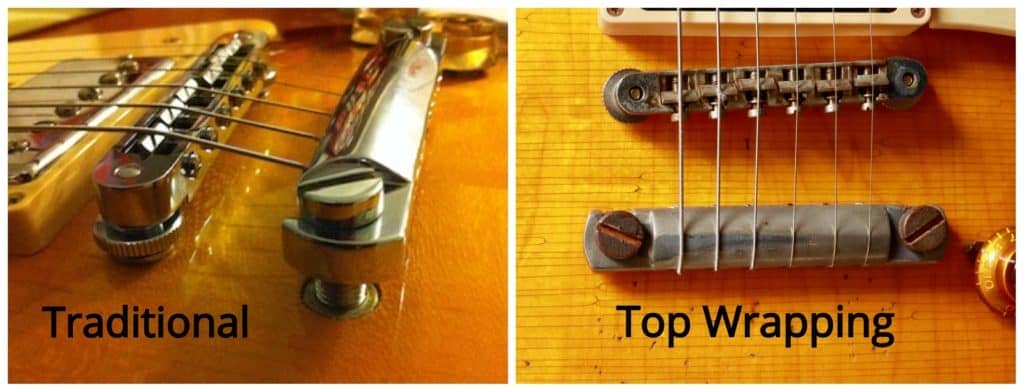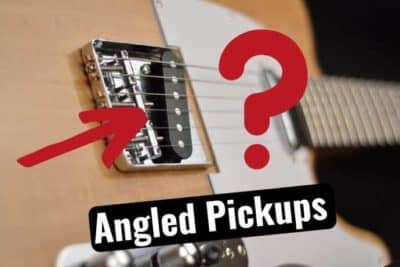
Ever wondered why some guitars incorporate a string thru body compared to a traditional stop tailpiece? Is one design better than the other?
This post will discuss the differences between guitars with a string thru design vs a guitar with a stop tailpiece bridge. Mainly comparing tone, function, and usability. Does this all sound good?
Now let’s unwrap the differences…
A string thru body is designed to promote increased sustain throughout the guitar, improving tone, and resonance. More Sustain allows notes to sound audible for longer. However, stoptail bridges are easier for changing strings.

Before We Begin
It has to be noted that neither a string thru (called “string through” on the internet) or tailpiece design is better than the other.
The reason is that a stop tail bridge has been a long staple of electric guitars in combination with the classic Tune-o-matic bridge setup.
You will commonly see this combination with Gibson and Epiphone guitars. So with that being said, the design that suits you depends on your personal preferences and tastes.
The function of a String Thru Body
A String thru design is a feature where all strings are anchored through the guitar’s body and mounted on the bridge and nut as usual.
The strings are laced through holes on the back of the body called ferrules. Each strings ball-end is then fixed inside the guitar by the ferrules as opposed to a saddle/stop tail as the image below shows.

So why do guitars have this design? Well, this feature is designed to transmit additional string energy and vibration throughout the guitar’s body. This allows the guitar’s pickups to more effectively pickup more of the vibrations.
This design is primarily used by some guitar brands to promote better sustain and resonance by feeding the string through the guitar for better energy transfer to the solid wood and pickups.
Why Sustain is Awesome
Sustain and resonance are great attributes for a guitar. Why? well, simply, the guitar is set up more effectively to produce better tones when it possesses more sustain and resonance.
More sustain allows notes to be held and remain audible for longer which all guitar players love.
Simply the string thru design allows for fewer points of contact for the string energy to be transmitted. Fewer points of contact enable the vibrations of the strings to transfer more effectively through the guitar’s body.
Hence the string thru design has been integrated on modern and vintage guitars to promote additional sustain and resonance.
Do String Thru Guitars Sustain More?
I have played guitars with a string thru body and some of them did not have crazy amounts of sustain. Probably because the guitar had a thin body, bolt-on neck, and single coil pickups.
On the other hand, I have played guitars with a regular tune-o matic bridge and stoptail. but these guitars had buckets more sustain and resonance than guitars with a string thru body (the Gibson Les Paul for example)!
Mainly because the guitar had a thick body, set neck, and dense wood as the body material.
The point is a string thru, or fixed saddle/bridge is not the deciding factor how well a guitar resonates and sustains. Therefore, it should not be a detail that is high on your list when choosing a guitar.
The deciding factor that influences a guitar’s ability to sustain is…
- Body shape
- Body weight
- Wood material
- Wood density
- Set neck / bolt-on neck
- Pickups
- Hardware
- Hardware weight
- String gauge
- Build quality
- Your vibrato
The verdict is that neither a string thru or fixed bridge guitar is better than the other when it comes to sustain. Mainly because there are so many factors that decide a guitar’s ability to sustain as mentioned above.
Both designs have their own distinct features and use depending on the player.
It’s like comparing coil-tapping and coil-splitting! Both have slightly different functions from one another. But the feature that trumps the other is the one that is best suited to the player’s preferences.
String Thru Body Benefits
Some players debate that string thru guitars have more ‘pop’ and ‘snap’ than guitars with a regular stop tailpiece setup, perhaps due to the more efficient energy transfer.
Another aspect is that some players state that string thru guitars has more mid-range tone than guitars with a regular stop tailpiece. And don’t forget that the string thru design is to promote more sustain than a stop tailpiece setup.
But keep in mind, there are lots of other variables affecting your guitars sustain, resonance, and tonality such as materials, wood, construction, hardware, pickups, and how the neck is fixed to the body.
Therefore, it is difficult to say that a string thru is better than a stop tailpiece as there are so many variables affecting tone and sustain. You have to use your own judgment when comparing guitar tones.
In my opinion, a string thru design looks cooler than the traditional stop tailpiece look. The reason is that it appears like the string is being devoured by the guitar. Some players like this look and is a common feature on popular metal guitars produced by Schecter.
Stop Tailpiece Benefits
Moving over to guitars with a regular stop tailpiece, players state that guitars with a stop tailpiece make string changes easier. As you simply slot the strings through the eyelets, anchor it on the bridge and machine heads and away you go.
But other reasons include…
1. Adjust Height to your Preferences
Some players like to raise the height of the stop bar to reduce the break angle of the strings in combination with the bridge.
The main reason why players do this is to relieve the tension of the strings making the strings feel slinkier allowing for less finger strength required for string bends.
(Be aware you will need to readjust your truss rodd if you do this)
Having a raised stoptail will also relieve tension on the string making strings less likely to break. This is useful if your playing style is hard, aggressive and emotional.
Guitars with stop tailpieces are more flexible to accommodate your guitars set up when it comes to playability. Compare this to a string thru body which does not have the option to change the break angle of the strings.
2. You Can ‘Top Wrap’ your Strings
Owning a guitar with a stop tailpiece is an advantage if you like top wrapping your strings with a ‘Tune-o-matic’ bridge and stop tailpiece setup. Top wrapping is not conventional but usually performed on Gibson and Epiphone style guitars.

Top wrapping is when you wrap the strings over the top of the tailpiece and rest them into place over the bridge as usual.
The rationale behind top wrapping is that strings feel more flexible and maneuverable to the fingers, especially during bends due to the shallower break angle. Even when playing heavy gauged strings.
Some players argue that this offers more sustain compared to the conventional stop tailpiece set up. Top wrapping is not a very common method of setting up a Tune-o-matic bridge and saddle setup.
However, a minority of players prefer this method with Les Pauls, SG, and other Tune-o-matic style guitars. If you haven’t tried it with your Epiphone or Gibson guitar, give it a go for yourself and see if you like it.
So if your guitar has a stop tailpiece, you have the option to give top wrapping a try, which obviously could not be performed with a string thru body guitar.
3. Use Different Materials
You also have more flexibility with a stop tailpiece as you can substitute stock tailpieces with different types and materials.
Some of these common materials are aluminum, brass, and copper to name a few. Players agree that different materials will improve tone and sustain based on how dense and heavy the materials are.
The reason being a stoptail piece composed from a denser material can transfer string vibrations to the body and wood better. Meaning more sustain and resonance.
Final Thoughts
Whether if the guitar has a string thru body or stoptail saddle, it’s not the main focus when buying a guitar as it mostly comes down to the player’s personal preference.
Some players like the look of the string through design but prefer the functionality of the stop tailpiece. So it ultimately comes down to the player’s choice.
Related Questions
Do pickups affect sustain?
Guitar pickups positively contribute to a guitar’s ability to sustain. Active pickups can amplify the vibration of the strings. It also depends on the pole pieces of the magnets, the height the pickups are set at, and the weight of the pickups.
Thanks for Reading
Have you ever wondered why some guitar pickups are angled? Like the single coil bridge pickup in a Telecaster and Stratocaster!
If you don’t, definitely check out my post… “Why Guitar Pickups are Angled”
Learn the reason why this simple yet interesting modification is made to guitar pickups.

